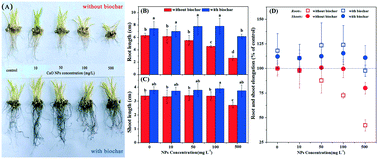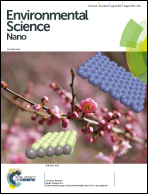Efficiently reducing the plant growth inhibition of CuO NPs using rice husk-derived biochar: experimental demonstration and mechanism investigation†
Abstract
CuO nanoparticles (NPs) have been widely used, and the inevitable release of Cu species into agricultural soil would bring potential toxicity to edible plants. Soil remediation may be the last barrier to block the entrance of Cu into the food chain of human beings. In this study, we experimentally demonstrated a new application of biochar which can significantly reduce the biotoxicity of CuO NPs on seed germination and growth of wheat (Triticum aestivum L.). The results showed that the 3% wt addition of biochar to a hydroponic culture system can completely eliminate the inhibition effect of CuO NPs on plant growth even with concentrations of CuO NPs up to 500 mg L−1, based on the comparison of germination rate, growth, and fresh and dry weight of wheat. The Cu content of shoots and roots decreased by 3.7–7.8 and 3.3–4.9 times in the presence of biochar, respectively. Further exploration indicated that both the adsorption of Cu2+ and space shield by biochar significantly suppress the entrance of Cu2+ and CuO NPs into plant cells and consequently reduce the biotoxicity of CuO NPs. These findings are of particular significance to increasing the production of crops while preventing the accumulation of metallic NPs in the food chain.



 Please wait while we load your content...
Please wait while we load your content...